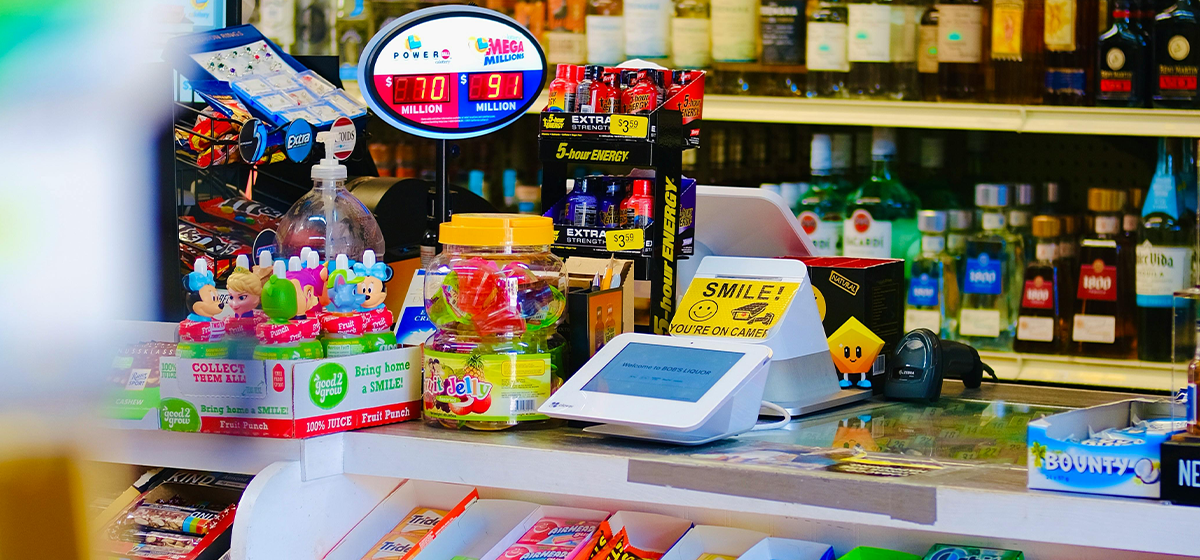Need a pint of milk or a loaf of bread? In the UK, it’s a familiar scenario, and the first place people go to is their local corner shop. It’s a British institution, and practically every neighbourhood in the country will have at least one convenience store within walking distance.
Retail might have taken a battering over the past few years, but the number of convenience stores has continued to rise. In 2013, the country had 5,013 shops, which has risen by 71% to 8,556 by today’s figures.
Far from being a saturated niche, there’s always room for another well-priced, well-stocked convenience shop at the heart of the community. But like any good shop, you can’t expect to open your doors and experience a profitable business.
In this ultimate guide, we’ll go through everything you must know about buying and launching your very own corner shop and how to plant the seeds for success.
Researching the convenience store industry
Every business plan starts by understanding the industry you’re about to operate in. Your local corner shop might appear to be something that rarely changes, but your first mistake is making assumptions.
Before you go any further, it’s time to investigate some of the latest trends influencing the industry. Some of these convenience store trends include:
- The overall increase in the size of the market.
- Fewer people smoking and more people vaping.
- Increasing demand for freshly baked goods.
- Combined services, including postal counters.
- Increased regulation of the food sector.
- A steady increase in people buying online.
These are examples of trends that convenience store owners must acknowledge and adapt to if they’re going to survive. In particular, one key trend is supermarkets wading into the sector. According to the latest stats, Tesco, Morrisons and Asda run 23% of all convenience stores in the UK.
Our full guide on the latest convenience store trends can get you started!

Buying an existing convenience store vs. opening a new store
Will you be taking over running an existing shop or opening a brand-new store?
Each option has its pros and cons. For example, taking control of an existing shop gives you a ready-made business with an established customer base, enabling you to pick up where the last owner left off. Conversely, if it’s a profitable shop, expect to pay a far larger purchase price.
On the other hand, opening a new shop empowers you to put your own stamp on your store. It’s a chance to build a brand and attract a whole new clientele from the ground up. Of course, opening a store has pitfalls because the infrastructure isn’t there, meaning significantly more work to get your shop ready for its grand opening.
There’s really no correct answer here. It’s a matter of personal preference and where you want to buy. For example, suppose you’re buying in an area already saturated with competition. In that case, buying an existing shop probably makes more sense than entering the market as another player.
Learn more about buying an existing convenience store vs opening a new one.
Valuing a convenience store for sale
Relatively speaking, the market for corner shops isn’t particularly large. Despite what you might hear, there’s no single rule for valuing this type of business. You can’t just deploy a multiple and expect to get an accurate valuation.
Instead, the best way to determine how much a convenience shop is worth is by examining other sales in your area. Working with an experienced negotiator and business expert is helpful for digging into the market and finding out what’s been going on in the last few years.
Remember, every sale is unique, and your number will likely depend on your negotiation skills and the willingness of both sides to compromise. Ultimately, you’ll have a budget, and the seller will have a figure.
You can learn more about valuing a convenience store for sale with a dedicated blog from our advisors.
Check Out the Latest Convenience Store Listings
Creating a business plan for opening a convenience store
Business plans form the foundation of your next venture. If you’re taking out financing, expect your prospective lender to ask for one. Like any business, a plan guides you during those early growth stages, directing your efforts and keeping you on track.
You’ll find plenty of business templates online if this is your first time creating a business plan. Remember, the foundations of a successful business are similar across all sectors, and the same goes for convenience stores.
Here are the ten points to cover as part of an effective business plan:
-
- Executive Summary – Essentially, this is the summary of your plan and aims to capture the essence of what you want your corner shop to look like and the goals you want to achieve.
- Business Description – Lay out your goals, who you’ll be targeting and what you’ll be selling.
- Market Analysis & Strategy – Research your local market and focus on the competition in your area. Use a Strengths, Weaknesses, Opportunities, Threats (SWOT) analysis for this section.
- Marketing and Sales – What strategies will your corner shop rely on to attract new customers through your doors? How are you going to build your brand and become that community hub?
- Competitive Analysis – A competitive analysis focuses on the competition. It discusses their market position, their strengths, and where their vulnerabilities lie. This is the platform for how you explain how your corner shop will be better.
- Management and Organisation – Who’s going to be running your business? What will they be doing? Why are they qualified? In many cases, it might just be you.
- Products and Services – Discuss the products you’ll include in your inventory. Will you offer other value-added services, such as a deli or freshly baked goods? What about cigarettes and alcohol?
- Operating Plan – Construct the structure of your organisation and how it will be run. Usually, this section is pretty straightforward for a corner shop, especially if it’s a one-man operation.
- Financial Projection – It’s time to get into the numbers. What are your target revenues and profits for the next three to five years? Be realistic because this is where so many entrepreneurs tend to artificially inflate their figures.
- Appendices – Appendices consist of extra relevant information, such as supporting documents. For example, if you’ve commissioned a market report for your local area, this is where it’ll be attached.
Remember, business plans are living documents, meaning they change over time. What you include in your business plan today can be changed later on. The most important thing is to get the skeleton of your convenience store down on paper.
Our fully detailed blog post goes into much more detail on creating your convenience store business plan – check it out!
Financing and funding options for opening a convenience store
Before you ever sell your first lottery ticket or pint of milk, the chances are you’ll be spending thousands. Getting the doors open for the first time is a chore, and convenience stores are no different to any other firm in this respect.
You’ll need inventory, equipment and more to get started. Typically, your costs will be substantially higher if starting a store from scratch instead of taking over an existing shop. Here are some of the financing options available to you:
- Self-financing.
- Family and friends.
- Government-backed loans.
- Bank loans.
- Angel investors.
- Crowdfunding.
If applying for a loan, take the time to read through the lender’s terms and conditions to avoid wasting your own time. Apply to multiple lenders to give yourself the best possible chance of success, and don’t be afraid to put up some collateral to increase your chances.
It’s not all doom and gloom in the UK’s small business lending industry, though. New data shows that only 15% of UK SMEs have recently been rejected for a loan, while 85% haven’t.
There are so many funding options available, it can be difficult to know what is right for you. Our brokers at Cogogo have collated a list of all the potential funding options you may want to consider when opening your new convenience store.

Choosing the right location for a convenience store
Think carefully about where your corner shop is. The general rule of thumb is that it should be within “slipper distance,” meaning that people can pop out in their pyjamas to make a quick purchase while taking the kids to school.
The location has made and broken countless businesses up and down history. Research a multitude of locations so that you have options to compare. Some of the aspects to consider include:
- Daily footfall
- Weekly footfall
- Public transport
- Local competition
- Parking options
- Safety
After all, there’s no point opening a corner shop on the very edge of a residential area when there are three well-established stores right in the heart of that area.
Remember, people value convenience with these retail businesses. It’s in the name.
Check out our list of the best places to buy a convenience store for more details.
If you’re ready to take the plunge, check out the latest listings on Cogogo today
Planning the layout and design of a convenience store
Layout and design matters. A cluttered mess will turn customers away. Clean and spacious are what customers expect, but what also matters is where you put your products to encourage those impulse buys and increase sales in your store. After all, it’s why you find chocolate bars next to the counter.
The key to any layout is that it should be easy to navigate with warm, ambient lighting. Customers should be able to walk into your shop and instantly know where to go. That’s why dividing your shop into “zones” is the standard way forward for all retail businesses.
In terms of your shop, you might have zones covering:
- High-impulse products, like chewing gum and sweets.
- Chilled products.
- Fresh products.
- Essentials, like bread and milk.
- Frozen foods.
- Beverages
- Services, like parcel collection.
Remember that the UK also has regulations on some items. For example, you can’t put cigarettes anywhere other than behind the counter, and they shouldn’t be on display. Other than that, opt for an open eyeline and opt for the classic “right-hand loop” because customers typically always turn right when entering a shop.
If you’re looking for some inspiration, walk into some corner shops and small retail stores near you for inspiration.
Choosing what to sell in your convenience store
Your customers will expect you to have what they want, but although the usual staples of bread, eggs, milk and canned foods are pretty obvious, there’s a lot of space to fill. Consider what the people in your area buy regularly by scoping out your competitors.
For example, if you live in an ethnically diverse area, consider the nationalities in your neighbourhood and the ethnic foods and ingredients they may enjoy.
Deciding what to sell is an ongoing process because items that don’t sell in sufficient quantities do nothing but take up too much shelf space. Use data analysis over time to track what’s selling and what’s going to waste. Don’t be afraid to be bold and test out new products to see what sticks.
Beyond products, consider the services you’ll be offering. In many cases, you’ll be restricted by the space available to you. Many entrepreneurs might want to sell fresh goods made on-site each day, but you might not have the space.
You’ll also have to consider the application process to add services to your shop, such as if you want to dispense National Lottery tickets. Likewise, if you want to sell alcohol, you’ll need to obtain the relevant license to do so.

Legal considerations when opening a convenience store
All convenience stores must follow the various rules and regulations that apply to other food businesses and retailers selling age-restricted products. Depending on what you’re selling and how you’re operating, you may need licenses like:
- Food business registration
- Premises license
- Alcohol premises license
- Music license
- Economic Operator Identifier Code/Facility Identifier Code (to sell tobacco)
Beyond licensing, there are various sections of the law you must think about. Examples of issues you’ll need to factor into your business plan include:
- Employment Law – If you’re hiring employees, you’ll need to ensure you’re paying the National Minimum Wage (NMW) and comply with issues like holiday time.
- Health and Safety – Health and safety applies to all businesses, but food businesses must also provide proper training and show compliance with food safety and handling procedures.
- Copyright – Will you be coming up with a unique brand? Copyright laws will also apply so you’re not infringing on someone else’s intellectual property.
- Data Protection – Launching a loyalty card scheme or doing something that involves collecting personal information? In this case, you’ll need to investigate and comply with the UK’s data security and privacy laws.
- Age–Restricted Items – Selling age-restricted items, like tobacco and alcohol, comes with its own rules. For example, it’s illegal to display cigarettes and tobacco openly.
Breaking the law could cause your otherwise successful venture to flounder. Inspections and audits can come at any time, so ensure that you not only comply but demonstrate continuing compliance with any laws and licensing rules that apply to your store.
To be sure that you remain compliant in your new venture, check out our full guide on the legalities of opening a convenience store!
Recruiting staff for your convenience store
Expanding your operation means hiring dedicated staff. A friendly face can mean the difference between customers coming back every day or shifting to one of your competitors. That’s why if you’re hiring, you need a bespoke recruitment strategy, including an interview process.
Remember, corner shops are as reliant on the people customers encounter as any other business. Take the time to get to know your candidates and check their experience to ensure they’re suitable for your shop.
Examples of traits to look for in candidates include:
- Communication skills
- Empathy
- Consideration
- Manners
- Previous experience
We go into much more detail in our blog around hiring the right candidates for your new corner shop!
Find your New Convenience Store Business in Our Listings
Like any business, you’ll go through a learning curve, making mistakes along the way. By following our guides and asking questions each step of the way, you’ve got the basics in place to launch your very own convenience store. If you’re ready to give your business plan the green light, Cogogo has hundreds of businesses listed for sale right now.
Use our business search tool to track down convenience stores for sale, or contact our friendly support team for help now.

